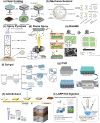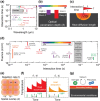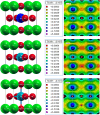Metal halide perovskites for energy applications: recent advances, challenges, and future perspectives
- PMID: 40575558
- PMCID: PMC12199149
- DOI: 10.1039/d5ra02730f
Metal halide perovskites for energy applications: recent advances, challenges, and future perspectives
Abstract
Metal halide perovskites (MHPs) have rapidly emerged as a leading class of materials for a wide range of energy applications, including photovoltaics, light-emitting devices, and energy storage systems. Their exceptional optoelectronic properties such as high absorption coefficients, long carrier diffusion lengths, and tunable bandgaps combined with their low-cost, solution-processable synthesis methods, position MHPs at the forefront of next-generation sustainable energy technologies. Despite these advantages, critical challenges remain, particularly concerning their long-term operational stability, environmental toxicity (especially due to the lead content), and scalability for industrial production. This review comprehensively examines recent progress in the synthesis and characterization of MHPs, focusing on key breakthroughs in materials design, processing techniques, and analytical tools that deepen our understanding of their structure property performance relationships. We also discuss the primary bottlenecks limiting commercial deployment and highlight emerging strategies to improve device durability, reduce ecological impact, and enhance compatibility with scalable manufacturing processes. Finally, we offer a forward-looking perspective on promising research directions aimed at expanding the applicability of MHPs beyond photovoltaics, including their potential roles in thermoelectric conversion, solid-state batteries, and advanced optoelectronic sensors, thereby underscoring their transformative potential in the future of clean energy technologies.
This journal is © The Royal Society of Chemistry.
Conflict of interest statement
The authors declare that they have no conflict of interest related to this work.
Figures

















Similar articles
-
From optoelectronics to scintillation applications: the versatility of lead-free halide double perovskites.Mater Horiz. 2025 Jun 25. doi: 10.1039/d5mh00573f. Online ahead of print. Mater Horiz. 2025. PMID: 40557602 Review.
-
Survivor, family and professional experiences of psychosocial interventions for sexual abuse and violence: a qualitative evidence synthesis.Cochrane Database Syst Rev. 2022 Oct 4;10(10):CD013648. doi: 10.1002/14651858.CD013648.pub2. Cochrane Database Syst Rev. 2022. PMID: 36194890 Free PMC article.
-
How lived experiences of illness trajectories, burdens of treatment, and social inequalities shape service user and caregiver participation in health and social care: a theory-informed qualitative evidence synthesis.Health Soc Care Deliv Res. 2025 Jun;13(24):1-120. doi: 10.3310/HGTQ8159. Health Soc Care Deliv Res. 2025. PMID: 40548558
-
Rapid molecular tests for tuberculosis and tuberculosis drug resistance: a qualitative evidence synthesis of recipient and provider views.Cochrane Database Syst Rev. 2022 Apr 26;4(4):CD014877. doi: 10.1002/14651858.CD014877.pub2. Cochrane Database Syst Rev. 2022. PMID: 35470432 Free PMC article.
-
Systemic pharmacological treatments for chronic plaque psoriasis: a network meta-analysis.Cochrane Database Syst Rev. 2021 Apr 19;4(4):CD011535. doi: 10.1002/14651858.CD011535.pub4. Cochrane Database Syst Rev. 2021. Update in: Cochrane Database Syst Rev. 2022 May 23;5:CD011535. doi: 10.1002/14651858.CD011535.pub5. PMID: 33871055 Free PMC article. Updated.
References
-
- Wang C. et al., On-demand airport slot management: tree-structured capacity profile and coadapted fire-break setting and slot allocation. Transp. A: Transp. Sci. 2024:1–35.
-
- Ye D. et al., PO-SRPP: A decentralized pivoting path planning method for self-reconfigurable satellites. IEEE Trans. Ind. Electron. 2024;71(11):14318–14327.
-
- Xiao Y. Yang Y. Ye D. Zhang J. Quantitative precision second-order temporal transformation-based pose control for spacecraft proximity operations. IEEE Trans. Aero. Electron. Syst. 2025;61(2):1931–1941.
-
- Xiao Y. Yang Y. Ye D. Zhao Y. Scaling-transformation based attitude tracking control for rigid spacecraft with prescribed time and prescribed bound. IEEE Trans. Aero. Electron. Syst. 2025;61(1):433–442.
-
- Zhang H. H. et al., 5G base station antenna array with heatsink radome. IEEE Trans. Antenn. Propag. 2024;72(3):2270–2278.
Publication types
LinkOut - more resources
Full Text Sources

